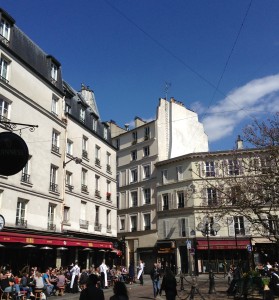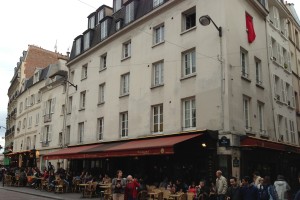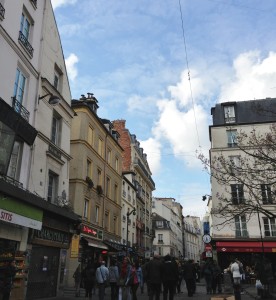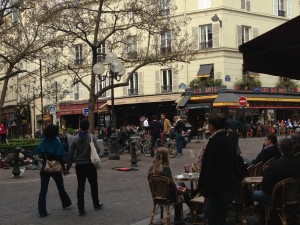Many significant Paris attractions were within easy reach of our small hotel by the Pantheon. Typically, we’d begin our excursions by heading down rue Soufflot. One afternoon during our visit twelve years ago, my husband and I took an opposite route. For us, and perhaps for the typical tourist, it was the road less traveled. We followed the narrow streets behind the Pantheon, down the hill for several blocks, to emerge onto a lively little square. The upper stories of the old buildings leaned in all around, as though in intimate discussion. We had stumbled upon La Place de la Contrescarpe.

It was a warm day in May, and we quickly settled into an inviting outdoor table at La Contrescarpe, one of several cafés bordering the square. We sipped our beers and watched locals running errands and socializing. The school day had recently ended, and the square was abuzz with activity and the musical sounds of French conversation. Teenagers from nearby lycées headed to the cafés or chatted by the fountain in the leafy center of the square. Parents and younger children paused for gelato, pastries and baguettes at the many small shops.

Because we discovered the square near the end of our trip, we didn’t get a chance to return. When we discussed plans for this visit, my husband and I agreed that we should go early and often to our favorite little Place. On our first day back in Paris last month, after leaving our bags at the hotel, we set off down the familiar streets for lunch at the café.
The square was just as we had remembered it, just as authentically French, still relatively untrodden by throngs of international tourists. Because the weather was sunny but chilly, we took an outside table within reach of an overhead heater. Thanks to these, April in Paris is more comfortable than ever. H and I ordered our celebratory “cinquantes,” 50-cl draft beers that we associate with an unhurried afternoon in France. Our daughter sampled her first Croque Monsieur. Or did she have the Croque Madame, topped with a fried egg? One of those, which she heartily enjoyed, along with her Orangina. The food was tasty, and the service was efficient and polite. The waiter understood our French without any apparent trouble. What’s more, he continued to address us in French, something we’ve learned to take as a compliment. It was quite the pleasure to be back.
La Contrescarpe became our local café, our destination for rest and refreshment after hours of sightseeing. It was a prime spot for viewing Parisian street theatre, which continued unabated. Several featured players, quirky character actors, as it were, returned again and again. Occasionally, when they became overly boisterous, they were courteously but firmly shooed away by the café staff. We enjoyed the feeling of being part of the scene.

I didn’t realize until after we had returned home that the Contrescarpe area, traditionally a working class district, has a rich historical association with writers. Rabelais frequented the area’s taverns. Balzac set much of Le Pere Goriot in the neighborhood. Victor Hugo’s Jean Valjean haunted its streets in Les Miserables. James Joyce wrote Ulysees there. George Orwell lived and worked in the neighborhood.
Its most evocative literary ties, however, may be with Hemingway. Just steps from the Place, and within sight of our table at La Contrescarpe, is the apartment at 74 rue Cardinal Lemoine, where he and his first wife lived in cheerful poetic poverty. On the opening page of A Moveable Feast, Hemingway writes how “the cold wind would strip the leaves from the trees in the Place Contrescarpe.” He rented a small garret room for writing around the corner on rue Descartes, in the same building where the poet Verlaine died in 1896.
I had generally avoided reading Hemingway because I wasn’t drawn to tales of bullfighting, fishing, boxing, or war. But A Moveable Feast, a memoir of his early years as a writer in Paris during the 1920s, had been on my to-read list seemingly forever. About two years ago, I read it. Hemingway’s Paris, so vividly and often comically evoked, was the Latin Quarter. “My” Paris. I remember appreciating the many references to my favorite spots, to the names of streets I traversed as a student. Like Hemingway, my friends and I were always on the lookout for cheap places to eat and drink. We were familiar with his Paris, of great beauty, bare-bones accommodations and inconvenient plumbing.
But the repeated mentions of La Place Contrescarpe, I’m disappointed to say, rang no bell of recognition. I recall thinking the unusual name sounded vaguely familiar, but I didn’t realize Hemingway’s first Paris home was immediately off that very same square H and I had enjoyed so much. I had no idea that as we sat at our favorite café table, we were facing the writer’s former “flat at the top of the hill.”
Hemingway avoided the café that adjoins the house he lived in. Then known as the Café des Amateurs, he described it as “the cesspool of the rue Mouffetard,” “a sad, evilly run café where the drunkards of the quarter crowded together.” While we didn’t sample the current café in that location, preferring our post across the street, it looked perfectly pleasant, neither sad nor evil. Obviously times change. I can’t help but be relieved, however, that it wasn’t La Contrescarpe or a previous incarnation that received such a bad review. I like to think there were spring evenings when Hemingway, happy after a successful day of writing, joined his wife Hadley at an outdoor table there on the Place de la Contrescarpe. Should he have appeared during our visit, “Midnight in Paris” style, my family and I would have been glad to clink glasses with him in a contented “Salut.” I know he would appreciate the cinquante as much as H and I did.

